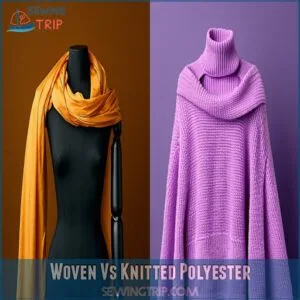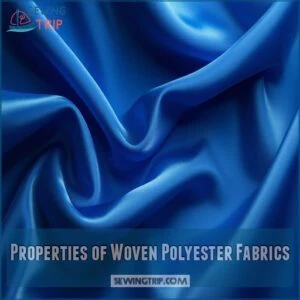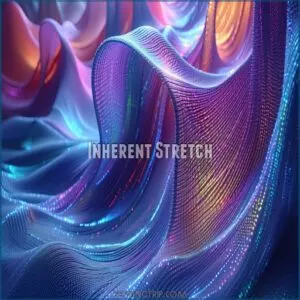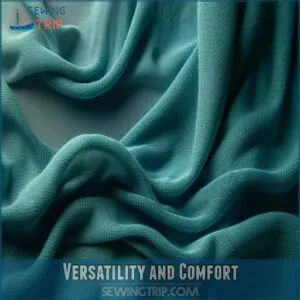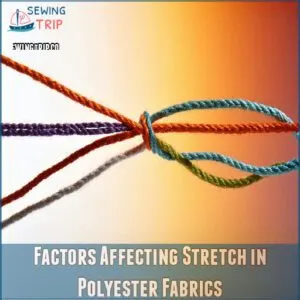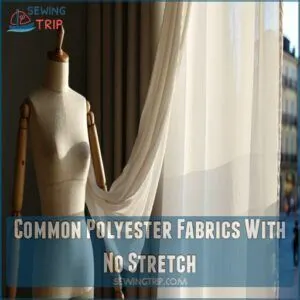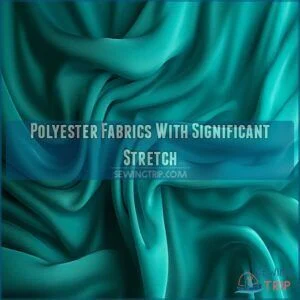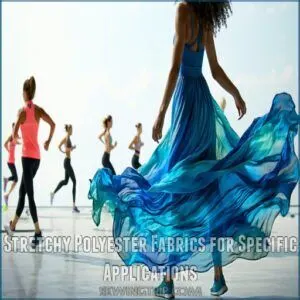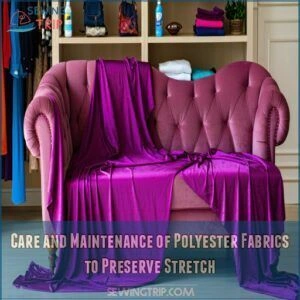This site is supported by our readers. We may earn a commission, at no cost to you, if you purchase through links.
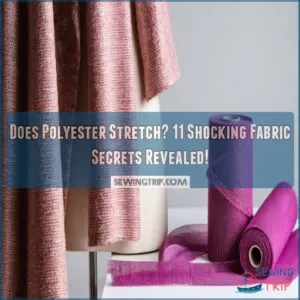
Woven polyester, with its tight, dense weave, offers minimal stretch and maintains crisp lines—perfect for structured garments.
Knitted polyester, however, is a different story.
Jersey and mesh varieties provide impressive 4-way stretch, moving with your body like a second skin.
Blending polyester with elastane supercharges its flexibility, making it ideal for activewear.
Fabric weight matters too; lightweight polyester stretches more easily than heavier varieties.
So, while pure polyester isn’t known for its stretch, modern fabric technologies have transformed this synthetic material into a versatile, movement-friendly fabric.
Table Of Contents
- Key Takeaways
- Woven Vs Knitted Polyester
- How to Determine if Your Polyester Fabric is Woven or Knitted
- Properties of Woven Polyester Fabrics
- Properties of Knitted Polyester Fabrics
- Factors Affecting Stretch in Polyester Fabrics
- Common Polyester Fabrics With No Stretch
- Common Polyester Fabrics With Minimal Stretch
- Polyester Fabrics With Significant Stretch
- Stretchy Polyester Fabrics for Specific Applications
- Care and Maintenance of Polyester Fabrics to Preserve Stretch
- Frequently Asked Questions (FAQs)
- Conclusion
Key Takeaways
- You’ll find that pure polyester has minimal stretch, especially in woven fabrics, but knitted polyester and blends with elastane offer significantly more flexibility.
- Check the fabric label carefully – a blend with just 2-5% elastane can transform rigid polyester into a stretchy, movement-friendly material perfect for activewear and comfortable clothing.
- Different polyester fabric types behave differently: jersey and mesh knits can stretch up to 30%, while plain-weave and chiffon polyester remain virtually non-stretchy.
- Your fabric’s stretch potential depends on key factors like blend ratio, thickness, and weave structure, so always feel the material and understand its specific characteristics before purchasing.
Woven Vs Knitted Polyester
Ever wondered why some polyester clothes stretch like a rubber band while others stay rigid as a board?
In the case of woven versus knitted polyester, the fabric’s construction determines how much give you’ll experience in your clothing.
Woven Fabrics
Have you ever felt the unyielding embrace of a woven polyester fabric? These textiles are engineering marvels, crafted through precise grid-like yarn interlacement that transforms flexibility into structured strength.
A detailed woven fabrics list examples details the diverse applications of this versatile material.
| Characteristic | Impact | Performance |
|---|---|---|
| Tight Weave | Minimal Stretch | Superior Stability |
| Dense Threads | Shape Retention | Controlled Fit |
| Rigid Structure | Low Elasticity | Durable Design |
Woven polyester fabrics stand as evidence to textile precision, offering unparalleled structural integrity. Their fabric density and intricate weave patterns create a material that refuses to compromise its shape.
These textiles excel in applications demanding crisp lines and consistent performance.
Whether you’re designing professional blazers or structured garments, woven polyester delivers reliability where other fabrics falter. Its thread counts and material blends guarantee a fabric that moves with purpose, not whim.
Knitted Fabrics
Shifting gears from rigid woven fabrics, knitted polyester bursts onto the scene with mind-blowing flexibility.
These fabric wizards stretch in ways that’ll make your wardrobe do backflips, offering unparalleled comfort and movement.
| Knit Type | Stretch Range | Best Use |
|---|---|---|
| Jersey | 4-Way Stretch | Activewear |
| Ponte | Substantial Flex | Dressy Layers |
| Mesh | Moderate Stretch | Performance Wear |
Blending polyester with elastane turns ordinary fabric into a superhero of stretch.
Each fiber works overtime, creating garments that bend, twist, and move exactly like you do.
From gym sessions to casual hangouts, knitted polyester adapts faster than you can change your mind, proving that comfort and style can totally coexist.
How to Determine if Your Polyester Fabric is Woven or Knitted
Cracking the code of polyester fabric starts with understanding its DNA-like thread structure.
Your fabric detective skills kick into high gear as you decipher the secrets hidden in plain sight.
Let’s unravel this textile mystery:
- Check thread alignment like a textile CSI
- Pinch and stretch with purpose
- Examine how light dances across the surface
- Hunt for loop structures or rigid grids
- Feel the fabric’s personality between your fingers
Understanding sewing with knit fabrics is vital for identifying the unique characteristics of knitted polyester.
Woven polyester forms a rigid battle grid, while knitted versions create a stretchy dance floor of interconnected loops.
Your fingertips are the ultimate fabric lie detector, and learning about sewing with knit fabrics can help you master the art of working with these materials.
Properties of Woven Polyester Fabrics
When you’re working with woven polyester fabrics, you’ll quickly discover they’re not known for their stretchiness.
You’ll find these fabrics maintain their shape with remarkable rigidity, offering durability and structure that’ll keep your garments looking crisp and consistent through countless wears.
Lack of Stretch
Most woven polyester fabrics are like rigid soldiers, refusing to budge an inch when you want them to stretch.
Your tight-weave textile is engineered for stability, not flexibility, turning movement into a challenging negotiation.
These textile warriors prioritize durability over dance-like movement.
When you need clothing that maintains crisp lines and resists wrinkles, woven polyester delivers.
But if you’re dreaming of garments that move like a second skin, you’ll find yourself wrestling with material weakness and elastic deficit.
| Fabric Behavior | Stretch Potential | Molecular Structure |
|---|---|---|
| Woven Polyester | Minimal | Tightly Interlaced |
| Stretch Resistance | High | Non-Elastic |
Durability and Structure
After wrestling with stretch limits, polyester’s durability emerges as a textile triumph.
Material science reveals how heat-set polymer chains create an unbreakable structural integrity that laughs at wear and tear.
Your favorite polyester piece isn’t just clothing—it’s engineered armor.
Fiber analysis shows these fabrics maintain shape through countless washes, with textile engineering transforming simple threads into resilient guardians of your wardrobe.
Think of it as a fabric that refuses to back down.
Properties of Knitted Polyester Fabrics
You’ll love how knitted polyester fabrics surprise you with their stretchy superpowers, offering comfort and flexibility that traditional woven materials can’t match.
When you slip on a knitted polyester garment, you’ll instantly feel the difference in how it moves with your body, hugging your curves and allowing unrestricted motion.
Inherent Stretch
Exploring polyester, you’ll discover its hidden superpower: inherent stretch.
Knitted polyester transforms molecular engineering into wearable flexibility, where polymer chains dance and weave to create remarkable elasticity.
Unlike rigid woven fabrics, these ingenious fibers bend and flex without losing shape, thanks to precise heat setting techniques.
Your polyester garment becomes a second skin, adapting to every movement with scientific precision.
Material science reveals that the fiber structure determines stretch limits, allowing textile physics to work its magic.
Fabric elasticity isn’t just a feature—it’s a carefully crafted performance of molecular innovation that gives you ultimate comfort and control.
Versatility and Comfort
After understanding polyester’s inherent stretch limitations, let’s explore how knitted polyester transforms into a comfort champion.
Your clothing becomes a performance powerhouse with unmatched versatility:
- Breathable fabric that moves with your body
- Adapts seamlessly to temperature changes
- Resists wrinkles like a pro
- Outlasts traditional materials
- Provides unrestricted mobility during activities
Knitted polyester isn’t just fabric—it’s your personal comfort revolution.
By blending innovative design with intelligent fiber technology, these garments deliver a second-skin experience that makes every movement feel effortless and natural.
Your active lifestyle deserves nothing less than this fabric’s remarkable flexibility.
Factors Affecting Stretch in Polyester Fabrics
Ever wondered why some polyester clothes stretch more than others?
The stretch in your favorite polyester garments depends on key factors like fabric blending, thickness, and weave structure that can dramatically transform its flexibility.
Blending With Elastane or Spandex
You want polyester that moves like a dream? Elastane and spandex are your secret weapons.
These synthetic fibers transform rigid polyester into a flexible fabric that breathes with your body. Even a small 2-5% elastane blend can turn stiff material into a form-fitting marvel.
Manufacturers leverage these polyester-spandex blends for activewear and performance clothing, creating fabrics that stretch, recover, and move seamlessly. Pure polyester might feel restrictive, but add a touch of elastane, and suddenly you’ve got a fabric that adapts to your every motion.
It’s like giving your clothes a built-in stretch pass – comfort meets performance in one smart blend. Understanding the polyester stretch properties is essential for selecting the right fabric for your needs.
Thickness and Weight of The Fabric
Some polyester fabrics reveal a secret superpower: their stretch potential depends directly on thickness.
Fabric density plays a vital role in flexibility, with weight determining how much give you’ll experience: A helpful fabric weight guide for sewing offers further insights into this relationship.
- Lightweight polyester stretches more readily
- Heavier fabrics resist movement
- Thinner materials offer greater elasticity
- Thick polyester maintains rigid structure
- Weight-to-elastane ratio controls stretch percentage
Your fabric’s personality? Thickness tells all, which is related to the fabric weight and stretch potential.
Common Polyester Fabrics With No Stretch
If you’re hunting for polyester fabrics that won’t budge when you stretch them, you’ll want to know about plain-weave and thin chiffon varieties.
These stiff, structured fabrics maintain their shape like a loyal soldier, refusing to give in to any tugging or pulling you might attempt, and are great examples of stiff fabrics.
Plain-weave Polyester
When you’re hunting for a fabric that won’t let you down, plain-weave polyester emerges as your rock-solid companion.
Its tightly interlaced threads create a fortress of stability that laughs in the face of stretching attempts.
- Zero elasticity means maximum structural integrity
- Industrial manufacturing prioritizes strength
- Perfect for precision-driven design needs
- Uncompromising performance across applications
Imagine a fabric so unyielding, it maintains its shape like a military-grade uniform.
The dense weave pattern locks threads together, creating a textile that refuses to budge.
Designers rely on plain-weave polyester when dimensional stability matters most, whether crafting crisp shirts, structured jackets, or home textiles that demand unwavering reliability.
Your garment won’t just look good—it’ll stand its ground, defying the stretch that lesser fabrics surrender to.
Thin Polyester Chiffon
After exploring plain-weave polyester’s rigid structure, you’ll find thin polyester chiffon takes inflexibility to new heights.
This transparent fabric laughs in the face of stretch, holding its shape like a determined statue.
With virtually no give, chiffon’s lightweight charm lies in its delicate open weave and impressive durability.
Machine-washable and wrinkle-resistant, chiffon slides effortlessly between layers without adding bulk.
It’s the ninja of fabrics: silent, precise, and always ready to make your outfit pop without compromising its pristine form.
Common Polyester Fabrics With Minimal Stretch
Not all polyester fabrics are created equal in terms of stretch, and you’ll find some surprising variations in their flexibility.
If you’re hunting for fabrics with just a hint of give, polyester georgette and polyester-cotton blends offer that subtle, minimal stretch you might be looking for.
Polyester Georgette
After exploring non-stretchy polyester fabrics, let’s uncover the secrets of polyester georgette.
This sheer, whisper-light fabric might fool you with its delicate charm, but it’s got minimal stretch that’ll keep you on your toes.
- Georgette’s lightweight texture creates an ethereal drape
- Minimal elasticity demands strategic styling choices
- Wrinkle-resistant properties guarantee long-lasting elegance
- Perfect for flowing garments that need subtle structure
You’ll want to choose designs that work with georgette’s natural flow, not against it.
Its slightly crinkled surface catches light beautifully, making it a go-to for blouses and summer dresses that move like a dream.
When shopping, remember: polyester georgette won’t cling or stretch, so focus on cut and silhouette to nail that perfect look.
Polyester-cotton Blends
After the shimmering world of polyester georgette, cotton-poly blends emerge as the unsung heroes of fabric versatility.
These lightweight warriors bring you 1) breathable comfort that whispers against your skin, 2) wrinkle-resistance that laughs in the face of morning rush chaos, and 3) affordable durability that outlasts pure cotton’s fragile promises.
Your wardrobe demands fabrics that move with purpose – not total stretch, but strategic flexibility.
Poly-cotton blends deliver that sweet spot between performance and practicality, giving you clothes that work as hard as you do.
Polyester Fabrics With Significant Stretch
You might be surprised to learn that not all polyester fabrics are stiff and unyielding.
When blended with elastane or spandex, polyester transforms into a stretchy, flexible fabric that moves with your body and adapts to your every motion.
Polyester-elastane Blends
Ready to supercharge your wardrobe with fabric that moves? Polyester-elastane blends are your secret weapon.
- Blend ratios typically hit 85/15 to 90/10 polyester to elastane
- Stretch ranges from 4-15%, giving you freedom of movement
- Perfect for athletic wear and business casual
- Moisture-wicking and wrinkle-resistant
- Maintains durability under tough conditions
Polyester knit fabric is a versatile textile used in various applications, from activewear to dresses, as detailed in this polyester fabric guide.
These dynamic fabrics adapt like a second skin, transforming ordinary polyester into a performance powerhouse. From workouts to office, you’ll feel unstoppable in clothing that bends and breathes with you.
Polyester Jersey
After exploring elastane blends, let’s zoom in on polyester jersey – the stretchy superhero of fabrics that’ll revolutionize your wardrobe.
This knit material packs a punch with serious flexibility:
- Offers up to 30% stretch for unbeatable movement
- Adapts from lightweight to heavyweight designs
- Conforms like a second skin in various applications
You can find a variety of stretch polyester jersey products online.
Jersey fabric transforms athletic wear and casual clothing with its incredible stretch recovery. Whether you’re crushing a workout or lounging around, this polyester blend moves with you effortlessly.
Its moisture-wicking properties keep you cool and comfortable, while the innovative knit structure guarantees you’re not sacrificing style for function. Pro tip: Choose jersey for garments that demand both performance and comfort – it’s your secret weapon in sportswear design.
Stretchy Polyester Fabrics for Specific Applications
If you’re hunting for polyester fabrics that move with you, you’ve hit the jackpot with our guide to stretchy applications.
Whether you’re an athlete, a fashion enthusiast, or just someone who craves comfort, we’ll show you exactly how specific polyester fabrics can flex and adapt to your every move.
Polyester Fleece
The warmth of fleece insulation transforms your winter wear experience, offering a surprising textile innovation that hugs your body with unparalleled comfort.
Polyester fleece stretches uniquely, particularly across its width, thanks to its densely knitted structure that promises freedom of movement.
You can find a variety of stretchy polyester fleece products online.
- Feel the fabric’s incredible thermal regulation that keeps you cozy in chilly conditions
- Experience lightweight construction that moves with your body effortlessly
- Enjoy water-resistant properties that laugh at light precipitation
- Discover remarkable durability that withstands outdoor adventures
Understanding the polyester stretch percentage matters – most fleece fabrics offer about 5-10% stretch with excellent recovery.
When you’re scaling mountain trails or lounging at home, this fabric delivers performance without compromising comfort.
Its softness whispers of technological triumph, blending function with feeling.
Gentle washing preserves fleece’s stretch and performance, ensuring your garment remains a reliable companion through countless winter journeys.
Polyester Mesh
Discover your inner performance hero with polyester mesh, the fabric that moves like a second skin.
This lightweight knitted marvel boasts incredible stretch and breathability, perfect for athletic wear and high-performance gear.
Its unique open-weave structure delivers remarkable elasticity, adapting to your every move.
You can find a variety of stretch polyester mesh products online.
Machine wash cold, avoid fabric softeners, and dry on low heat to maintain its magical properties.
From gym sessions to outdoor adventures, polyester mesh is your flexible, reliable companion.
Care and Maintenance of Polyester Fabrics to Preserve Stretch
If you want your polyester clothes to keep their stretch and shape, you’ll need to follow some smart care techniques.
Gentle washing, avoiding high heat, and proper storage can help maintain the fabric’s elasticity and prevent unwanted deformation of your favorite stretchy garments.
Washing and Drying Tips
Preserving the stretch and shape of your polyester garments starts with smart laundry techniques.
Cold water is your fabric’s best ally, protecting its elasticity and preventing unwanted shrinkage.
Opt for gentle detergents designed specifically for delicate fabrics to maintain their quality.
- Shield your clothes from harsh chemicals
- Skip fabric softeners that can damage fibers
- Choose low-heat drying settings
- Air dry when possible
- Handle with care to maintain stretch
Machine washing? Use the gentlest cycle.
Avoid bleach and high temperatures that can break down polyester’s structure.
Think of your clothing like a precision instrument – each wash should be a careful, calculated move to keep your threads looking crisp, feeling comfortable, and ready for action.
Handling and Storage Recommendations
When you hang up your polyester threads, you’ll keep their stretch game strong.
Opt for wide, padded hangers that prevent shoulder bumps and maintain garment shape.
Avoid cramming clothes in tight spaces, which can cause permanent stretching or fabric distortion.
Store delicate pieces in breathable garment bags, protecting them from dust and sunlight.
Fold heavier items like fleece using tissue paper between layers to prevent creasing.
Rotate your wardrobe periodically to distribute wear and preserve the fabric’s stretch recovery capabilities, ensuring your clothes stay flexible and fabulous with a good garment shape.
Frequently Asked Questions (FAQs)
Does polyester stretch when wet?
Worried about your polyester clothing losing shape?
Don’t sweat it!
Polyester barely stretches when wet.
Its synthetic fibers resist moisture-induced stretching, maintaining your garment’s original fit and structure during washing or sweaty workouts, which helps preserve the original fit.
Do polyester clothes stretch?
You’ll find most polyester clothes won’t stretch much on their own.
Blending with spandex or elastane can increase flexibility, so check the fabric label to know if your specific garment offers the stretch you’re looking for.
How do you stretch polyester?
Like a stubborn mule resisting a pull, polyester needs special tricks to stretch. Dampen the fabric, apply gentle heat, and use strategic stretching techniques. Always be cautious to prevent damage.
Does 100% polyester stretch?
If you’re eyeing a pure polyester garment, don’t expect much stretch.
It’s stiff and holds its shape, with minimal give.
Blending it with elastane or spandex boosts flexibility, making your clothes more comfortable and movement-friendly.
Is polyester stretchy or non-stretchy?
Not all heroes stretch.
Pure polyester’s rigidity surprises many, but blended with elastane, it transforms.
You’ll find most performance wear offers flexible movement, thanks to smart fabric engineering that adds just the right amount of give.
What makes polyester stretchy?
You’ll boost polyester’s stretch by blending it with elastic fibers like spandex or using knitted weaves.
The right mix can give your fabric up to 15% more flexibility for comfortable, movement-friendly clothing.
Is Polyester Stretchy?
With 62% of performance wear using polyester blends, you’ll find most stretchy polyester isn’t pure fabric.
It gains flexibility through elastane or spandex additions, giving you comfortable, movement-friendly clothing that looks sharp and feels great.
How Does Polyester Fit?
You’ll need the right blend to get a comfortable fit.
Pure polyester won’t stretch much, but mixing it with spandex or elastane gives you flexibility.
Check the label and feel the fabric before buying to confirm it meets your movement needs.
How Does Polyester Feel?
With 95% of activewear now using polyester blends, you’ll feel this fabric’s smooth, slightly stiff texture.
It’s not super soft but offers durability and a lightweight feel that moves with your body without clinging uncomfortably.
Will Polyester Shrink?
You’ll find polyester doesn’t typically shrink much.
Wash in cold water, dry on low heat, and avoid high temperatures.
Some minimal shrinkage might occur, but proper care keeps your garments looking sharp and fitting well.
Conclusion
Simply put, you’ve got the lowdown on polyester stretch now!
Whether you’re shopping for activewear or a structured blazer, understanding fabric composition is key.
Don’t let fabric myths confuse you—woven polyester offers minimal stretch, while knitted varieties and elastane blends provide impressive flexibility.
Your fabric choice depends on your needs, so always check labels and feel the material before buying.
Remember, does polyester stretch? It totally depends!

